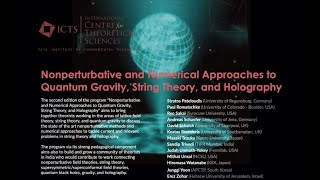
Model Theory - part 01 - The Setup in Classical Set Valued Model Theory
Here we give the basic setup for Model Theory. I learned this from a talk Tom Scanlon gave in 2010 at CUNY.
From playlist Model Theory

Natural Models of Type Theory - Steve Awodey
Steve Awodey Carnegie Mellon University; Member, School of Mathematics March 28, 2013 For more videos, visit http://video.ias.edu
From playlist Mathematics

Model Theory - part 07 - Semantics pt 1
This is the first video on semantics.
From playlist Model Theory

Model Theory - part 03 - Terms, Formulas, Sequents
He we are a little bit more precise about keeping track of what fragments of formal languages we are using. This becomes relevant when you want to interpret them later. Caramello's book was useful in preparing this. We also found the post on nCatLab useful.
From playlist Model Theory

Model Theory - part 04 - Posets, Lattices, Heyting Algebras, Booleans Algebras
This is a short video for people who haven't seen a Heyting algebras before. There is really nothing special in it that doesn't show up in wikipedia or ncatlab. I just wanted to review it before we use them. Errata: *at 3:35: there the law should read (a and (a or b) ), not (a and (a and
From playlist Model Theory

A Practical Introduction to Interpretations.
We give a definition that is necessary for the construction of Hodge Theaters.
From playlist Model Theory

Model Theory - part 02 - Signatures, Lawvere Categories, Structures (now valued in Categories!)
I learned about this approach from Riehl in the existential context here. Her webpage is here: http://www.math.jhu.edu/~eriehl/ Also, I found the refrences by Caramello and Awodey very helpful. They build on what is done in Reyes-Makkai. Whatever Awodey writes is basically gold. Here he
From playlist Model Theory

Model Theory - part 08 - Syntactic Catgories
These are the categories where functors from these dudes are models... these take forever to define. On top of it, these end up just being friggin' definable sets and definable morphisms!! I remember being a place in here where there is a diagram which i say commutes but I need to actually
From playlist Model Theory

On the Setoid Model of Type Theory - Erik Palmgren
Erik Palmgren University of Stockholm October 18, 2012 For more videos, visit http://video.ias.edu
From playlist Mathematics

Absolute notions in model theory - M. Dzamonja - Workshop 1 - CEB T1 2018
Mirna Dzamonja (East Anglia) / 30.01.2018 The wonderful theory of stability and ranks developed for many notions in first order model theory implies that many model theoretic constructions are absolute, since they can be expressed in terms of internal properties measurable by the existenc
From playlist 2018 - T1 - Model Theory, Combinatorics and Valued fields

Matrix Models, Gauge-Gravity Duality and Simulations on the Lattice by Georg Bergner
PROGRAM NONPERTURBATIVE AND NUMERICAL APPROACHES TO QUANTUM GRAVITY, STRING THEORY AND HOLOGRAPHY (HYBRID) ORGANIZERS: David Berenstein (University of California, Santa Barbara, USA), Simon Catterall (Syracuse University, USA), Masanori Hanada (University of Surrey, UK), Anosh Joseph (II
From playlist NUMSTRING 2022

CDIS 4017 - Models of Speech Production Part 1 (Done)
Chaya Guntupalli (Nanjundeswaran) Ph.D. CDIS 4017 - Speech and Hearing Science I ETSU Online Programs - http://www.etsu.edu/online
From playlist ETSU: CDIS 4017 - Speech and Hearing Science I | CosmoLearning Audiology

Inflation and Supergravity - A. Linde - 5/17/2014
Workshop on Primordial Gravitational Waves and Cosmology (May 16 - 17, 2014) Learn more about this workshop: http://burkeinstitute.caltech.edu/workshops Produced in association with Caltech Academic Media Technologies. © 2014 California Institute of Technology
From playlist Walter Burke Institute for Theoretical Physics - Workshop on Primordial Gravitational Waves and Cosmology (May 16 - 17, 2014)

Abraham Robinson’s legacy in model theory and (...) - L. Van den Dries - Workshop 3 - CEB T1 2018
Lou Van den Dries (University of Illinois, Urbana) / 27.03.2018 Abraham Robinson’s legacy in model theory and its applications ---------------------------------- Vous pouvez nous rejoindre sur les réseaux sociaux pour suivre nos actualités. Facebook : https://www.facebook.com/InstitutHe
From playlist 2018 - T1 - Model Theory, Combinatorics and Valued fields

The Large SpeNta Limit by David Gross
11 January 2017 to 13 January 2017 VENUE: Ramanujan Lecture Hall, ICTS, Bengaluru String theory has come a long way, from its origin in 1970's as a possible model of strong interactions, to the present day where it sheds light not only on the original problem of strong interactions, but
From playlist String Theory: Past and Present

Kavli Distinguished Lecture SPEAKER: David Gross (KITP - University of California, Santa Barbara) DATE & TIME: 08 January 2018, 09:00 to 10:30 VENUE: Ramanujan Lecture Hall, ICTS, Bengaluru Abstract: A perspective on large N theories: their role in quantum field theory, in gauge-gravit
From playlist Kavli Asian Winter School (KAWS) on Strings, Particles and Cosmology 2018

Qubit Regularization of Asymptotic Freedom by Shailesh Chandrasekharan
PROGRAM Nonperturbative and Numerical Approaches to Quantum Gravity, String Theory and Holography (ONLINE) ORGANIZERS: David Berenstein (UCSB), Simon Catterall (Syracuse University), Masanori Hanada (University of Surrey), Anosh Joseph (IISER, Mohali), Jun Nishimura (KEK Japan), David Sc
From playlist Nonperturbative and Numerical Approaches to Quantum Gravity, String Theory and Holography (Online)

Washington Taylor - How Natural is the Standard Model in the String Landscape?
Mike's pioneering work in taking a statistical approach to string vacua has contributed to an ever-improving picture of the landscape of solutions of string theory. In this talk, we explore how such statistical ideas may be relevant in understanding how natural different realizations of th
From playlist Mikefest: A conference in honor of Michael Douglas' 60th birthday

Sebastian Reich (DDMCS@Turing): Learning models by making them interact
Complex models in all areas of science and engineering, and in the social sciences, must be reduced to a relatively small number of variables for practical computation and accurate prediction. In general, it is difficult to identify and parameterize the crucial features that must be incorp
From playlist Data driven modelling of complex systems
